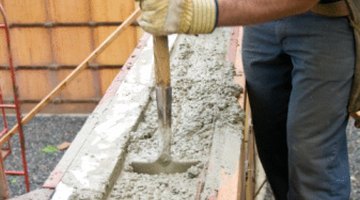The Effects of Portland Cement on Aluminum
Aluminum and Portland cement are common building materials because both are strong, weatherproof and require little maintenance. However, aluminum reacts with some ingredients in wet cement, which can result in structural damage and unsafe construction.

Proper steps can be taken to ensure that aluminum window and door frames, for instance, receive no harmful effects from cement during construction.
Reaction
Construction-grade aluminum is a relatively stable metal that resists corrosion because of a layer of aluminum hydroxide that forms when the metal is exposed to air. The metal loses its corrosion resistance, however, when exposed to salts and differing pH levels. Both occur in wet cement, which is highly alkali and contains alkali salts. These salts in wet cement react with aluminum, causing the metal to weaken and lose its resistance to the elements.
Prevention
Despite aluminum's aversion to wet cement, both are commonly used side-by-side in new construction. This is possible because dried cement does not have the same reactive properties as wet cement. As cement cures, its pH drops to near a neutral 7 and the alkali salts become strongly bonded within the mortar. Aluminum can then be fitted into a cement frame as long as a caulk or thick paint forms a barrier between the two materials.
Uses
Aluminum's most common use in construction is for window and door frames, which must be held fast to cement frames. The American Architectural Manufacturers Association recommends using only coated window frames for installation into cement openings. These coatings can be organics, such as bituminous paint, or inorganics, like anodized aluminum or zinc. Paint is the most common and should be sufficient to provide a lasting barrier as long as it isn't scratched or dented prior to installation.
Construction
Cement frames should be built and allowed to cure several weeks before any aluminum is affixed. This allows the alkali salts to harden in the cement. Even so, alkali can migrate to aluminum, particularly in wet or harsh climates. To reduce the likelihood of salt coming into contact with aluminum, frames should be secured to the dry cement with cement screws and a 1/2-inch gap left between the frame and the cement. This gap is then filled with siliconized caulk.
References
Writer Bio
Sam Smith has worked as a professional writer since 2005. His work appears in several publications including "Sauk Valley Newspapers," the Rochester "Post Bulletin" and the "Guardian" of Nassau, Bahamas. Smith received a Master of Science in journalism from the University of Illinois.
Photo Credits
- Jupiterimages/Photos.com/Getty Images
- Jupiterimages/Photos.com/Getty Images
More Articles



